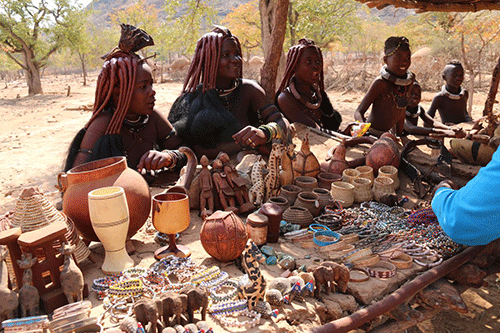OPUWO- About 40 kilometres north of Opuwo lies a rich, real-life cultural experience of the Ovahimba people, a marginalised group which is seen as backward, yet destined to keep its heritage alive and educate the world about the way of life.
Walking through the museum, one can see children playing, while others are busy with daily chores as the day begins.
The Ovahimba Living Museum is a true homestead with more than 40 inhabitants. But due to the dry climate, some members have moved to higher ground with their animals to seek better grazing.
George Tjipurua (32) is a guide at the living museum, a job he has been doing for the past eight years.
“The most important task that I take to heart and seriously is teaching visitors our way of life, how and why we do what do, and the reason why we keep the culture alive,” he stated passionately.
Tjipurua said the interest in people knowing how the Ovahimba live is great, especially from foreigners who come from far, just to experience and walk in the kraal, milk cows and arch the goats, sheep and chicken.
“Sometimes, depending on the season, we would have two or three groups per day. In our programme, we have quite a variety of activities, ranging from a demonstration of a typical day at the village, bushwalk - walking around mountains - and talking about traditional medicine and so forth,” he added.
A significant and most loved activity, especially by women, is wearing traditional attire and having their bodies painted.
“There is also an interest in visitors finding out about how we make our cups and other utensils, so we also introduced that craft-ship aspect to teach them that. I am happy that people are curious about our way of life and equally excited to enlighten them about it,” said Tjipura, who also acts as a translator at the museum.
The living museum has cows, goats, sheep and chickens. It is in a mountainous area strategically located between the Ovahimba capital Opuwo and the paradisiac Epupa Falls at the Kunene River.
“The animals are ours that we bought, while some were also brought by other people. We don’t treat this place like a living museum; to us this is home. Everything that happens here is real, we just decided to show that to the world,” he beamed.
The group aspires to add more animals, but it is difficult to do that as the weather is not favourable.
Tjipurua said: “Additionally, we do need help with food. When you work with people, there are always certain demands. So, it is almost impossible for you to cater to everyone, and we thus do need a lot of things. The income which we get from the tours that we charge is usually distributed among the people.”
He noted that because the people living at the museum are coming from various places in the region, one finds some who are from very poor backgrounds. Therefore, it is important to consider them when distributing these funds so that they could better themselves and get the necessities they require.
“We are not complicated beings, and we are not technical or demanding. Our livelihood is based on animals, as without animals we can’t survive,” he acknowledged.
As far as health is concerned of the people living in the area, Tjipurua said frequent medical issues which arise include the usual headache, flu and stomach ache, which are addressed through natural remedies.
“We have Mopani trees, with leaves that are either chewed or boiled in water, and drank. We use the roots of the Terminalia tomentosa tree to also chew, and sometimes boil and drink hot water when we are having flu. We likewise have tree species like Commiphora, but overall we have a lot of trees which we use to treat illnesses. These are things that we expose to our visitors, who are having a keen interest in how we survive through this nomadic lifestyle,” he continued.
About 24 children who live in the village attend schools in nearby areas. Younger ones are gearing up for kindergarten, something that Mukaundaka Tjindunda (32) is happy about.
“I have been staying here for more than seven years. I have seven children, and three of them were born here. It’s a beautiful place I call home, and I’m happy that the outside world can get to see it”, said the energetic beadsmaker as she applies a mixture of butterfat and ochre pigment on her arms.
She said life is good, but it could be better if they had access to more goods like food. Hence, she makes wristbands and other jewellery to earn an extra income.
The tourism ministry’s spokesperson Romeo Muyunda said they have been encouraging the diversification of tourism products to attract more people.
“The Ovahimba Living Museum and all the other similar products are important additions promoting cultural tourism. It’s crucial that for a country that upholds cultural diversity, we show off and share our culture with the rest of the world. The beauty about these initiatives is that it empowers people at grassroots levels by providing employment and income- generation opportunities,” he stated.
Muyunda added that the country’s tourism is an important economic sector as it does not only contribute to the GDP of the country, but also to income-generation and employment-creation. Cultural tourism, like the living museum, add diversity to the tourism product offerings of the country.
He said: “This is one area in our view that has potential in our quest to maximize the tourism benefits. We encourage that more cultural heritage tourism products be developed by Namibians.”
- psiririka@nepc.com.na
- Photos: Paheja Siririka


